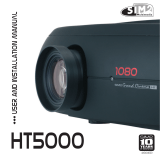
Switching the projector off
Pay attention to the switch off procedure for the projector. The projector must always
be brought back to the standby state to allow the projector to carry out the cooling
procedure. Should this not happen, for example due to a power cut, the projector may
enter a state of protection that leads to switch-on being blocked. This block will last
until the internal components of the projector have completely cooled down.
Changing the fuses
Before changing the fuse, disconnect the projector from the mains power supply. The
fuse compartment is next to the power supply connector. Remove the fuse holder
with a flat head screwdriver and replace the fuse. Fit the replacement fuse. Use only
type T 10 A L H fuses for the projector.
Be careful with cables
Make sure cables are routed so that people are not impeded or become a trip hazard.
Keep all cables away from children. Install the projector as close to the wall socket as
possible. Avoid stepping on power cords, make certain they do not become tangled,
and never jerk or tug them; do not expose them to sources of heat, and make sure
they do not become knotted or crimped. If the power cords become damaged, stop
using the projector and request the assistance of an authorized technician.
Disconnect the projector from the mains power during electrical storms and when
not in use
To prevent damage from lightning strikes in the vicinity, disconnect the projector
during storms or when the projector is going to be left unused for a long time.
Avoid contact with liquids and exposure to damp
Do not use the projector near water (sinks, tubs and so on); do not place objects
containing liquids on or near the projector and do not expose it to rain, humidity,
drops of water or sprays; do not use water or liquid detergent to clean it.
Place the projector on a stable surface
Place the projector on a stable surface or use a suitable ceiling mounting bracket.
Never place the projector on its side or rear, on the lens or top panel.
Do not allow the projector to overheat
To prevent overheating, allow a free space of at least 0.25 m (10 in.) on the left, right
and rear sides of the projector. Do not obstruct the ventilation slots. Do not place the
projector near heat sources such as heaters, radiators or other devices (including
amplifiers) that generate heat. Do not place the projector in an area where there is
insufficient space (shelving units, bookshelves and so on) and in general avoid placing
it in poorly ventilated areas as this may prevent sufficient cooling and significantly
reduce lamp life.
Never look directly at the projection lamp
Never look directly into the lens when the lamp is on as the intense light may damage
your eyes. Take particular care that children cannot do so.
Take special care regarding movement of the lens
Do not place objects in the slots on the side of the lens and also ensure that vertical
lens movements are not impeded by external objects.
Important information LUMIS20TH
User Guide
4






















